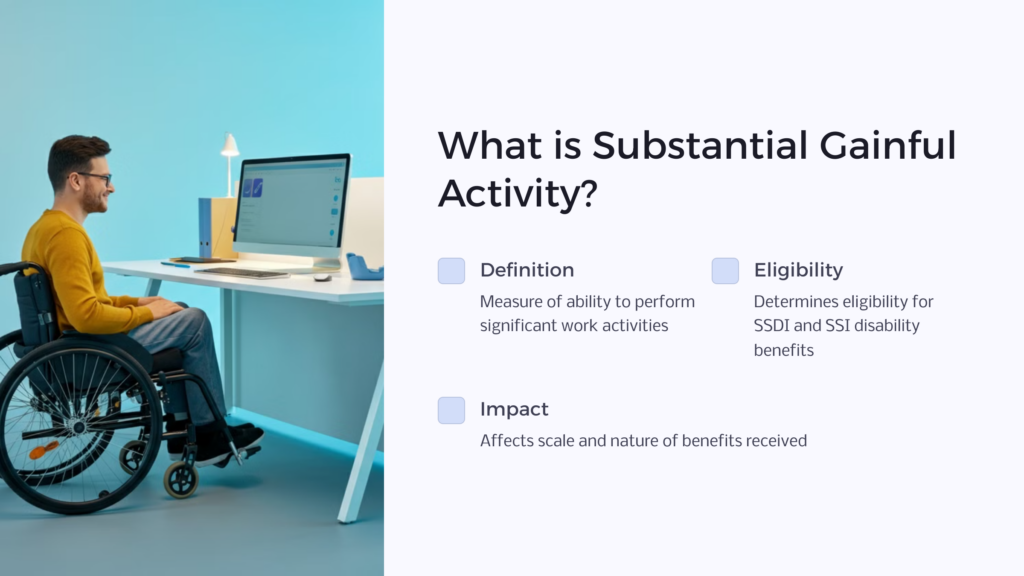Understanding the financial mechanics of the Social Security program can be a complex task. The Social Security program offers retirement, disability, and survivor benefits to eligible individuals. Social Security disability benefits provide income support for individuals who are unable to work due to a qualifying condition. At its core, disability benefits rely heavily on concepts such as Substantial Gainful Activity (SGA), a standard that determines eligibility for disability benefits. In turn, the SGA forms a critical determinant of the scale and nature of the benefits that an individual can hope to receive. The purpose of this article is to delve into the intricate mechanisms of SGA and most importantly, establish a prediction of the Social Security substantial earnings for the year 2025.
Understanding Substantial Gainful Activity

In the landscape of Social Security, Substantial Gainful Activity constitutes a measure of an individual’s ability to execute significant physical or mental activities in a work environment. Earning an income above the substantial earnings limit may disqualify an individual from receiving Social Security disability benefits. More than just ‘work’, the SGA is a specific level of work that renders one ineligible to receive Social Security Disability Insurance (SSDI).
It plays an equally pivotal role in the realm of Supplemental Security Income (SSI). More specifically, SGA helps in determining whether an adult is eligible for SSI disability benefits. As a result, the precise SGA amount has a considerable flow-on effect on the benefits received by individuals from SSDI and SSI.
The differing SGA amounts for blind and non-blind beneficiaries acknowledge that those who are statutorily blind may face higher expenses or accommodation needs, so a higher income threshold applies before benefits are terminated. This aims to provide additional support for the blind community in their attempts to gain financial independence through employment.
2025 Substantial Gainful Activity Amounts
For 2025, the monthly SGA amount for non-blind disability beneficiaries is $1,620 and the monthly SGA amount for statutorily blind disability beneficiaries is $2,700.

If a disabled individual earns above the SGA amount based on their work activity, they generally cannot be considered disabled under Social Security guidelines. Some exceptions apply, such as during a trial work period where an SSDI beneficiary can test their ability to work for at least 9 months. However, after the trial period has concluded, earning over the SGA limit will result in a cessation of SSDI benefits.
The SGA rule is meant to encourage disabled individuals to return to the workforce without immediately losing their disability benefit eligibility. This overlap of social security earnings allows some flexibility for part-time work or attempts at easing back into employment. However, eventually making over the earnings limit indicates an ability for substantial and gainful work, meaning all social security earnings should cease.
The SGA amounts are adjusted annually based on the national average wage index, so the current 2025 figures of $1,620 monthly for non-blind individuals and $2,700 monthly for blind individuals reflect the latest cost-of-living adjustments. Understanding these updated thresholds can help social security recipients and beneficiaries better navigate the rules of disability benefit, retirement benefit, and government pension amounts.
An important update as of 2025, the Social Security Fairness Act has been signed into effect, eliminating the reduction of Social Security benefits when also entitled to work-provided public pensions not covered by Social Security. This will help ensure equitable treatment for public sector employees. However, the Social Security Administration is still determining the best way to implement the Act, so it will be important to regularly check for updated information to see how the Social Security Fairness Act will affect you.
Predicting Social Security Substantial Earnings for 2026

Predicting the future is always playing a guessing game. However, using historical data and analyzing current policy trends may offer a reasonable idea of what to expect. Considering these factors, it is anticipated that the SGA amounts for 2026 will likely rise slightly in line with the national average wage index’s inflation.
How Changes in SGA Affect Social Security Beneficiaries
Changes in the SGA have significant implications for Social Security beneficiaries. For instance, if the SGA amount increases, a person with disability may earn more and still qualify for Social Security Disability Insurance (SSDI) benefits, offering them a chance to maintain an improved standard of living.
Alternatively, while SGA plays a key role in determining initial eligibility for both SSDI and Supplemental Security Income (SSI), it does not directly impact ongoing SSI benefits. For SSI, eligibility after qualification depends primarily on income and resource limits. Therefore, a person who initially qualified under SGA standards would not lose SSI solely due to an increase in the SGA amount, unless their income or resources exceed the allowable limits.
Additionally, an individual who could only work part-time due to their disability might find themselves suddenly reclassified as capable of substantial gainful activity if their earnings exceed the SGA limit, which could result in a loss of SSDI benefits. For SSI, exceeding the income or resource limits would lead to reduced or terminated benefits. Thus, SGA changes carry profound impacts, particularly for SSDI beneficiaries, and can significantly affect individuals’ financial stability.
Conclusion and Implications for the Future
SGA is not just a fixed measurement but a moving entity within the Social Security framework. As we move forward, the SGA amounts are poised to evolve, influenced by several determinants including policy changes, economic factors, and sociodemographic transitions.
These foreseeable changes carry a multitude of implications for Social Security beneficiaries. Therefore, it is of utmost importance for potential and current beneficiaries to stay up to date with the latest developments around SGA.
Check us out at Benefits.com and take our quiz so we can get started helping you on your path to receiving benefits.
 Benefits.com Advisors
Benefits.com Advisors
With expertise spanning local, state, and federal benefit programs, our team is dedicated to guiding individuals towards the perfect program tailored to their unique circumstances.
Rise to the top with Peak Benefits!
Join our Peak Benefits Newsletter for the latest news, resources, and offers on all things government benefits.




















